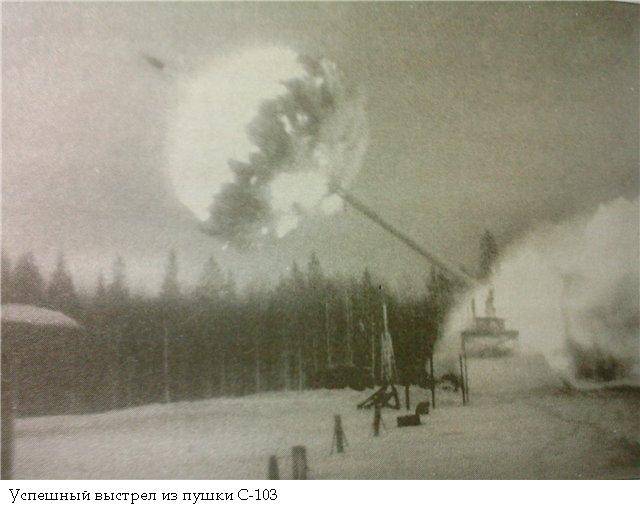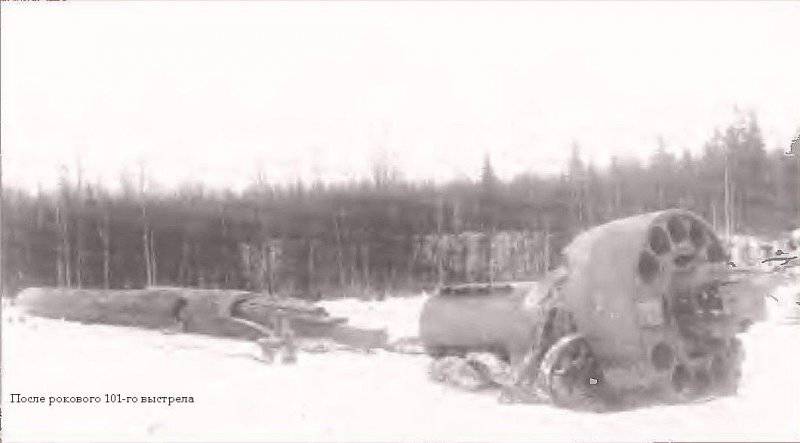Project of self-propelled artillery installation with recoilless C-103 gun
Work on the subject of a promising recoilless gun on a self-propelled chassis started at the Central Research Institute-58 (in 1959, it was attached to the OKB-1, now RSC Energia) under the direction of VG Grabina back in 1947 year. The project "7940" meant the development of "active-reactive" gun caliber 280 mm. This project remained on paper, but some of his ideas were later used in the development of the 0842 self-propelled gun with an 406-mm recoilless tool. It was this project in 1954 that became the basis for the C-103 ACS designed for firing nuclear projectiles.
Recoilless gun was of great interest for both designers and military. Created in the early fifties self-propelled guns 2B1 "Oka" and 2А3 "Capacitor" had extremely high returns, which made special demands on the design of the gun and the base machine. Taking into account the caliber and the required power of the propellant charge, the recoilless circuit seemed to be a sufficiently convenient and simple solution to this problem.
As a chassis for the promising self-propelled artillery mount S-103 was considered a machine based on heavy tank T-10M. In the mid-fifties, Leningrad designers created two such chassis, designed for self-propelled guns “Oka” and “Condenser”. They had to develop and chassis for the S-103. It is known that some self-propelled chassis was used in testing the prototype of the S-103 gun, however, there is no detailed information about it. There is only a picture depicting a self-propelled gun assembly.
At a certain stage of the development of the C-103 project, a proposal appeared to make a so-called. artillery duplex: two self-propelled guns with 280 and 420 mm caliber guns, having the highest possible degree of unification. It is known that the 420-mm gun was designed and built for testing. An 280 mm caliber cannon could also be built, but due to problems with a larger caliber gun, it remained on paper.
Both recoilless guns developed under the C-103 project should have a similar design. On a tracked chassis, it was proposed to mount an artillery system with horizontal and vertical guidance mechanisms. Unlike other atomic “super guns,” the C-103 self-propelled guns did not need serious recoil devices or a base plate to compensate for extremely high recoil.
The gun itself was to consist of a rifled barrel and a breech of a relatively complex structure. To ensure the effective throwing of a heavy 420-mm projectile and recoil compensation, a number of interesting solutions had to be used in the design of the gun. Thus, the projectile was proposed to be placed in the breech breech, separated from the chamber for propellant charge by a septum-diaphragm. A similar partition should have been located in the back of the chamber for charge and separated from the frame with nozzle openings. To avoid damage, the breech of the implement should have relatively thick walls.
The shot of a gun of this design should look like this. The propellant powder charge is burned in its separate chamber, forming an overpressure at the level of 2000 kg / sq. see. Part of the powder gases through the holes in the anterior septum-diaphragm enters the barrel and pushes the projectile. The remaining gases through another partition enter the pre-chamber and leave the gun passing through the nozzles. Due to the correct combination of the size of the holes in the partitions and the dimensions of the nozzles, it was planned to achieve the most efficient use of the energy of powder gases and full compensation of recoil.
The project SAU C-103 was extremely difficult. He demanded many trials and practical testing of various ideas. For these purposes, in the CRI-58 were designed the so-called. ballistic installations: experienced recoilless guns 0132BU and 0114BU. The first had a caliber 280 mm, the second - 420 mm. Tests of the prospective "artillery duplex", it was decided to start with a larger caliber system.
In 1955, plant No. XXUMX (now the Barrikady software, Volgograd) was commissioned to manufacture the barrel and the breech block of the 221BU ballistic installation. Production of these units was completed in November. Soon after, the specialists of the TsNII-0114 specialists connected the barrel with the breech and sent them to the Rzhevka training ground near Leningrad.

The first experimental shooting was carried out using the stand of free kickback. The 0114BU gun was installed on the stand and prepared for firing. The purpose of the first shots was to determine the optimal propellant charge and to work out the equilibrium of the barrel. The first shot of the gun made 13 January 1956 of the year. During the first stage of testing, six shots were fired, including two idle.
The sixth shot, made by 18 in January, ended in an accident. The design of the gun could not stand the pressure and collapsed. The gun tore along the groove of the first thread. The breech threw back a few meters, and the trunk flew forward. Fortunately, only the breech cannon was seriously damaged. The barrel with minor damage that does not affect its characteristics could be used in further work.
Testers and designers identified the cause of the accident and made a new breech with minor modifications. She connected with the remaining trunk. This time, the assembled gun was mounted not on the ground stand, but on the self-propelled tracked chassis.
16 May 1956, the test resumed. The shooting continued until July 17, when the gun was sent for examination and refinement. Tests of a slightly upgraded version of the C-103 ACS were conducted from September 29 to November 29 of the same year. Testing tools "0114BU" ended in late November due to an accident. In the course of the next shot, the gun again exploded. To the chagrin of the authors of the project, this time the destruction was much more serious than in January. The restoration of the damaged ballistic installation was impossible, and the construction of a new one was considered inexpedient.
Before the first accident, the 0114BU installation made 6 shots (including emergency shots). The fatal shot of 29 November became 95-m in the series, which began in May, and 101-m for the trunk.
Analysis of the information collected during the tests showed that further continuation of work on the C-103 project does not make sense. The recoilless gun, with all its advantages over other “super-tools” of that time, had dubious prospects and was too complicated. Soon after the completion of the tests of the 0114BU ballistic installation VG Grabin and employees of the Central Research Institute-58 stopped all work on the project.
It is noteworthy that the disappearance of a competitor in the face of ACS C-103 did not affect the fate of the mortar 2B1 "Oka" and self-propelled gun 2А3 "Condenser". In the late fifties, this technique was tested and even took part in a parade on the Red Square 7 in November 1957 of the year. However, the "Oka" and "Capacitor" did not become serial. They were too complicated to manufacture and operate, and according to their characteristics they were seriously inferior to tactical missile systems, the development of which began at that time. As a result, C-103 and other atomic "super-tools" remained interesting developments that did not lead to any practical result.
Based on:
http://strangernn.livejournal.com/
http://raigap.livejournal.com/
http://armoredgun.org/
Shirokorad A.B. Atomic ram of the XX century. - M .: “Veche”, 2005


Information